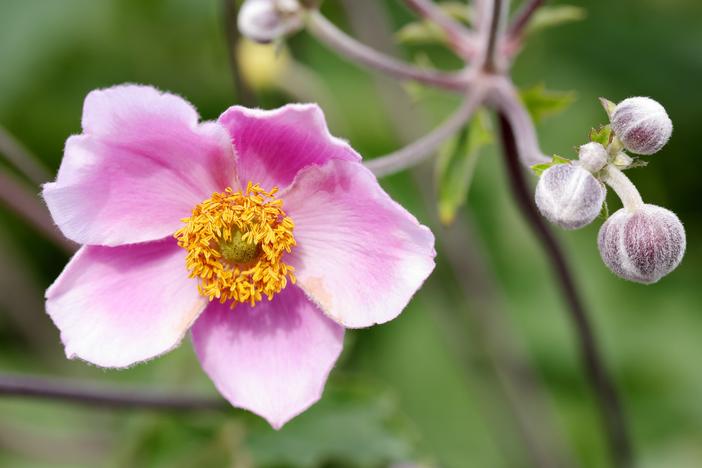Japanese Anemone
(Eriocapitella hupehensis)
Japanese Anemone (Eriocapitella hupehensis)
/
/

Cephas
CC BY-SA 4.0
Image By:
Cephas
Recorded By:
Copyright:
CC BY-SA 4.0
Copyright Notice:
Photo by: Cephas | License Type: CC BY-SA 4.0 | License URL: https://creativecommons.org/licenses/by-sa/4.0 | Uploader: Cephas | Publisher: Wikipedia Commons














































Estimated Native Range
Summary
Eriocapitella hupehensis, commonly known as Japanese Anemone, is a deciduous perennial herb originally from the Eastern Himalayas, Taiwan, and Southeast Asia, where it thrives in forest margins, grassy slopes, and stream banks. It typically grows to 0.6–1.2 meters (2–4 feet) in height and spreads via rhizomes to form clumps. The plant features deeply lobed leaves and tall, wiry stems that bear the flowers. Each flower, blooming from late summer to fall, is approximately 5 cm (2.0 in) across and consists of showy sepals that resemble petals; wild types usually have 5 sepals, but cultivated varieties can have double flowers with around 20 sepals. The sepals come in shades of purple, purple-red, pink, or white, adding a burst of late-season color to the garden.
Japanese Anemone is valued for its elegant flowers and extended blooming period, making it a popular choice for borders, cottage gardens, and woodland settings. It is relatively low maintenance, but benefits from deadheading to promote additional blooms. In cultivation, it prefers full sun to part shade, consistent moisture, and well-drained soil. Popular cultivars include ’Hadspen Abundance’ with pale purple flowers, ’Praecox’ with pink flowers, and ’Superba’ with semi-double lavender pink flowers. The cultivars ’Bowles’s Pink’ and ’Hadspen Abundance’ have received the Award of Garden Merit (AGM) from the Royal Horticultural Society. While generally disease-resistant, Japanese Anemone can suffer from foliar diseases in overly wet conditions and can become invasive if not managed, spreading aggressively in favorable conditions.CC BY-SA 4.0
Japanese Anemone is valued for its elegant flowers and extended blooming period, making it a popular choice for borders, cottage gardens, and woodland settings. It is relatively low maintenance, but benefits from deadheading to promote additional blooms. In cultivation, it prefers full sun to part shade, consistent moisture, and well-drained soil. Popular cultivars include ’Hadspen Abundance’ with pale purple flowers, ’Praecox’ with pink flowers, and ’Superba’ with semi-double lavender pink flowers. The cultivars ’Bowles’s Pink’ and ’Hadspen Abundance’ have received the Award of Garden Merit (AGM) from the Royal Horticultural Society. While generally disease-resistant, Japanese Anemone can suffer from foliar diseases in overly wet conditions and can become invasive if not managed, spreading aggressively in favorable conditions.CC BY-SA 4.0
Plant Description
- Plant Type: Herb
- Height: 1.5-2.5 feet
- Width: 1-1.5 feet
- Growth Rate: Moderate
- Flower Color: Pink, White
- Flowering Season: Summer, Fall
- Leaf Retention: Deciduous
Growth Requirements
- Sun: Full Sun, Part Shade
- Water: Medium
- Drainage: Medium
Common Uses
Bee Garden, Border Plant, Butterfly Garden, Deer Resistant, Erosion Control, Groundcover, Low Maintenance, Potted Plant, Rabbit Resistant, Showy Flowers, Street Planting
Natural Habitat
Forest margins, grassy slopes, and stream banks
Other Names
Common Names: Japanese Thimbleweed, Dǎ Pò Wǎn Huā Huā, Broken Bowl Flower
Scientific Names: , Anemone hupehensis, Anemone hupensis, Eriocapitella hupehensis, Anemone matsudae, Anemone japonica var. hupehensis, Anemone vitifolia var. matsudae, Eriocapitella vitifolia var. matsudae,
GBIF Accepted Name: Eriocapitella hupehensis (Lemoine) Christenh. & Byng